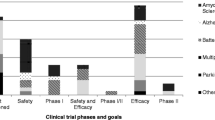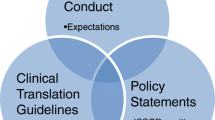Abstract
Stem cells continue to garner attention by the news media and play a role in public and policy discussions of emerging technologies. As new media platforms develop, it is important to understand how different news media represents emerging stem cell technologies and the role these play in public discussions. We conducted a comparative analysis of newspaper and sports websites coverage of one recent high profile case: Gordie Howe’s stem cell treatment in Mexico. Using qualitative coding methods, we analyzed news articles and readers’ comments from Canadian and US newspapers and sports websites. Results indicate that the efficacy of stem cell treatments is often assumed in news coverage and readers’ comments indicate a public with a wide array of beliefs and perspectives on stem cells and their clinical efficacy. Media coverage that presents uncritical perspectives on unproven stem cell therapies may create patient expectations, may have an affect on policy discussions, and help to feed the marketing of unproven therapies. However, news coverage that provides more balanced or critical coverage of unproven stem cell treatments may also inspire more critical discussion, as reflected in readers’ comments.
Similar content being viewed by others
References
Caulfield, T., & McGuire, A. (2012). Athletes’ use of unproven stem cell therapies: adding to inappropriate media hype? Molecular Therapy, 20(9), 1656–1658.
Chang, W., Bank, T. C., & Scott, C. T. (2014). Fit to print? Media accounts of unproven medical treatments across time. AJOB Empirical Bioethics, 5(1), 33–43.
Ogbogu, U., Du, L., Rachul, C., Bélanger, L., & Caulfield, T. (2013). Chinese newspaper coverage of (unproven) stem cell therapies and their providers. Stem Cell Reviews and Reports, 9(2), 111–118.
Petersen, A., & Seear, K. (2011). Technologies of hope: techniques of the online advertising of stem cell treatments. New Genetics and Society, 30(4), 329–346.
Zarzeczny, A., Rachul, C., Nisbet, M., & Caulfield, T. (2010). Stem cell clinics in the news. Nature Biotechnology, 28, 1243–1246.
The associated press. (2015). Stem cell ‘wild west’ takes root amid lack of US regulation. New York Times, May 18, http://www.nytimes.com/aponline/2015/05/18/us/ap-us-stem-cell-clinics-abridged.html. Accessed 3 June 2015.
Seidman, K. (2015). Saviour or snake oil?; seeking out medical care in another country can offer relief to patients ensnared in our cash-strapped health system, but some call it a costly charade preying on false hope. Edmonton Journal, February 21.
Rachul, C., Percec, I., & Caulfield, T. (2015). The fountain of stem cell-based youth? Online portrayals of anti-aging stem cell technologies. Aesthetic Surgery Journal, DOI: 10.1093/asj/sju111.
Bubela, T., Li, M. D., Hafez, M., Bieber, M., & Atkins, H. (2012). Is belief larger than fact: expectations, optimism and reality for translational stem cell research. BMC Medicine, 10(1), 133.
McIntosh, K. (2005). Exaggerated claims of cures threaten stem cell research. British Medical Journal, 330(7503), 1285.
Burman, R. J. (2014). The battle against stem cell hype : are we doing enough? Can the medical and scientific community do more to support regulatory boards in advocating ethical evidence-based medicine?: opinion. South African Journal of Bioethics and Law, 7, 74–75.
MacGregor, C., Petersen, A., & Munsie, M. (2015). Stem cell tourism: Selling hope through unproven stem cell treatments - lessons from the X-Cell Center controversy. Euro Stem Cell, http://www.eurostemcell.org/commentanalysis/stem-cell-tourism-selling-hope-through-unproven-stem-cell-treatments-lessons-x-cell-. Accessed 3 June 2015.
van Lente, H., Spitters, C., & Peine, A. (2013). Comparing technological hype cycles: towards a theory. Technological Forecasting & Social Change, 80(8), 1615–1628.
Ryan, K. A., Sanders, A. N., Wang, D. D., & Levine, A. D. (2010). Tracking the rise of stem cell tourism. Regenerative Medicine, 5(1), 27–33.
Matthews, K. R. W., & Cuchiara, M. L. (2014). U.S. National football league athletes seeking unproven stem cell treatments. Stem Cells and Development, 23(S1), 60–64.
Kamenova, K., Reshef, A., & Caulfield, T. (2014). Angelina Jolie’s faulty gene: newspaper coverage of a celebrity’s preventive bilateral mastectomy in Canada, the United States, and the United Kingdom. Genetics in Medicine, 16, 522–528.
MacKenzie, R., Chapman, S., Barratt, A., & Holding, S. (2007). ‘The news is [not] all good’: misrepresentations and inaccuracies in Australian news media reports on prostate cancer screening. Medical Journal of Australia, 187, 507–510.
Barabas, J., & Jerit, J. (2009). Estimating the causal effects of media coverage on policy-specific knowledge. American Journal of Political Science, 53, 73–89.
Gamson, W. A., & Modigliani, A. (1989). Media discourse and public opinion on nuclear power: a constructionist approach. American Journal of Sociology, 95, 1–37.
Scheufele, D. A. (1999). Framing as a theory of media effects. Journal of Communication, 49, 103–122.
Fox, S., & Duggan, M. (2013). Health Online 2013. Pew Research Center, January 15, http://www.pewinternet.org/2013/01/15/health-online-2013/. Accessed 3 June 2015.
Research Canada. (2007). Media Science Forum: Public opinion research results. http://files.voog.com/0000/0024/8635/files/RC-MediaScienceForum_ PORPoll_Dec2007_Report.pdf. Accessed 3 June 2015.
Whiteside, E., Nan, Y., & Hardin, M. (2012). The new “toy department”?: a case study on differences in sports coverage between traditional and new media. Journal of Sports Media, 7(1), 23–38.
Henrich, N., & Holmes, B. (2011). What the public was saying about the H1N1 vaccine: perceptions and issues discussed in on-line comments during the 2009 H1N1 pandemic. PloS One, 6(4), e18479.
Kareklas, I., Muehling, D. D., & Weber, T. J. (2015). Re-examining health messages in the digital age: a fresh look at source credibility effects. Journal of Advertising, 44(2), 88–104.
The associated press. (2014). Howe’s family report rapid improvement. New York Times, December 19, http://www.nytimes.com/aponline/2014/12/19/sports/hockey/ap-hkn-howe-stroke.html?_r=0. Accessed 3 June 2015.
Illes, J., & Rossi, F. (2015). Opinion: No miracle therapy for stroke. Vancouver Sun, February 12, http://www.vancouversun.com/health/Opinion+miracle+therapy+stroke/10787468/story.html. Accessed 3 June 2015.
Price, J., & Rossant, J. (2015). Make Canada a magnet for stem cell trials. The Globe and Mail, February 23, http://www.theglobeandmail.com/globe-debate/make-canada-a-magnet-for-stem-cell-trials/article23148618/. Accessed 3 June 2015.
EBiz MBA. (2015). Top 15 most popular sports websites: February 2015. February, http://www.ebizmba.com/articles/sports-websites. Accessed 11 April 2015.
Alliance for audited media. (2013). Top 25 U.S. newspapers for March 2013. March, http://auditedmedia.com/news/research-and-data/top-25-us-newspapers-for-march-2013.aspx. Accessed 11 April 2015.
Newspapers Canada. (2014). Daily newspaper circulation data. http://www.newspaperscanada.ca/daily-newspaper-circulation-data. Accessed 11 April 2015.
Saldaña, J. (2013). The coding manual for qualitative researchers (2nd ed., ). Los Angeles:Sage.
Gretz, A. (2014). Gordie Howe’s condition improving following stem cell treatment. CBS Sports, December 19, http://www.cbssports.com/nhl/eye-on-hockey/24903245/gordie-howes-condition-improving-following-stem-cell-treatment. Accessed 3 June 2015.
Pullman, D., Zarzeczny, A., & Picard, A. (2013). Media, politics and science policy: MS and evidence from the CCSVI trenches. BMC Medical Ethics, 14, 6.
Ubelacker, S. (2015). Gordie Howe’s ‘miracle’ in Mexico stirs experts' doubts about stem-cell therapy. The Globe and Mail, January 29, http://www.theglobeandmail.com/life/health-and-fitness/health/gordie-howes-miracle-in-mexico-stirs-experts-doubts-about-stem-cell-therapy/article22695984/. Accessed 3 June 2015.
Ubelacker, S. (2015). Medical experts question Gordie Howe stem cell ‘miracle’. The Toronto Star, January 29, http://www.thestar.com/news/gta/2015/01/29/medical-experts-question-gordie-howe-stem-cell-miracle.html. Accessed 3 June 2015.
Picard, A. (2015). The stem-cell ‘miracle’ is anecdotal. The Globe and Mail, February 10, http://www.theglobeandmail.com/globe-debate/the-stem-cell-miracle-is-anecdotal/article22880977/. Accessed 3 June 2015.
Rachul, C. (2011). “What have I got to lose?”: an analysis of stem cell therapy patients' blogs. Health Law Review, 20(1), 5–12.
Sturgis, P., & Allum, N. (2004). Science in society: Re-evaluating the deficit model of public attitudes. Public Understanding of Science, 13, 55–74.
Sweet, M. (2007). Beware the stem cell hard sell. Sydney Alumni Magazine, Autumn, http://www.alumni.sydney.edu.au/s/965/images/editor_documents/alumni-magazine/07-winter/2007-winter-research.pdf. Accessed 3 June 2015.
McMahon, D.S. (2014). The global industry for unproven stem cell interventions and stem cell tourism. Tissue Engineering and Regenerative Medicine, 11(1), 1–9.
Kiatpongsan, S., & Sipp, D. (2008). Offshore stem cell treatments. Nature Reports Stem Cells, December 3, http://www.nature.com/stemcells/2008/0812/081203/full/stemcells.2008.151.html. Accessed 3 June 2015.
Caulfield, T., Rachul, C., & Zarzeczny, A. (2012). The evolution of policy issues in stem cell research: an international survey. Stem Cell Reviews and Reports, 8(4), 1037–1042.
Einsiedel, E. F., & Adamson, H. (2012). Stem cell tourism and future stem cell tourists: policy and ethical implications. Developing World Bioethics, 12(1), 35–44.
Cohen, C. B., & Cohen, P. J. (2010). Stem cell tourism in Russia and India: clinical research, innovative treatment, or unproven hype? Kennedy Institute of Ethics Journal, 20(1), 27–49.
Neuman, D. (2015). Stem cell treatment gives local family new lease on life. St. Albert Gazette, February 28, http://www.stalbertgazette.com/article/20150228/SAG9604/302289988. Accessed 3 June 2015.
Acknowledgments
We gratefully acknowledge the generous funding support provided by the Canadian National Transplant Research Program and Canada’s Stem Cell Network for funding. We also thank Nathaniel Brenneis for research assistance and the team at the Health Law Institute at the University of Alberta, Edmonton, Canada.
Disclosures
The authors indicate no potential conflicts of interest.
Author information
Authors and Affiliations
Corresponding authors
Electronic supplementary material
ESM 1
(DOCX 123 kb)
Rights and permissions
About this article
Cite this article
Rachul, C., Caulfield, T. Gordie Howe’s Stem Cell ‘Miracle’: A Qualitative Analysis of News Coverage and Readers’ Comments in Newspapers and Sports Websites. Stem Cell Rev and Rep 11, 667–675 (2015). https://doi.org/10.1007/s12015-015-9606-8
Published:
Issue Date:
DOI: https://doi.org/10.1007/s12015-015-9606-8




